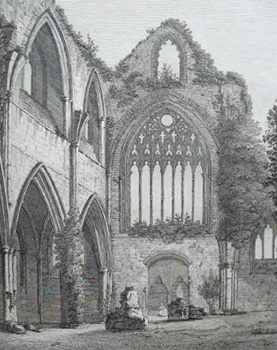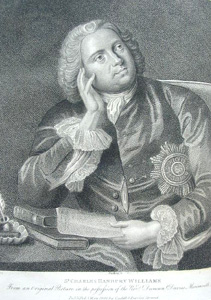An Historical Tour Through Monmouthshire by William Coxe
 In fact the book, published in 1801, is a result of three tours by the author William Coxe. On the first, in 1798, he was accompanied bySir Richard Colt Hoare who provided some of the illustrations for the book and there were then two further tours on his own, in the spring and autumn of 1799.
In fact the book, published in 1801, is a result of three tours by the author William Coxe. On the first, in 1798, he was accompanied bySir Richard Colt Hoare who provided some of the illustrations for the book and there were then two further tours on his own, in the spring and autumn of 1799.
William Coxe (1747 – 1828) was educated at Eton and ultimately became a vicar in Wiltshire. He wrote a number of biographiesincluding those of Sir Robert Walpole and the Duke of Marlborough, as well as travel books, covering amongst others, Switzerland,Russia and Poland. However, for those of us based in Wales, his most sought after and collectable book remains “An Historical Tour Through Monmouthshire”
 Sir Richard Colt Hoare (1758-1838), a renowned antiquarian in his own right, lived at Stourhead in Wiltshire and is perhaps best known for “The Ancient History of Wiltshire”.
Sir Richard Colt Hoare (1758-1838), a renowned antiquarian in his own right, lived at Stourhead in Wiltshire and is perhaps best known for “The Ancient History of Wiltshire”.
Coxe, in the preface to “The Tour”, thanks his friend Henry Penruddocke Wyndham who, although he was an MP for Wiltshire, also wrote “A Gentleman's Tour Through Monmouthshire and Wales”( 1775). Quite why Wiltshire was the home to three people who wrote such famous books about Monmouthshire I have no idea!
In his turn Coxe has been used by subsequent historians when writing about Monmouthshire, for example,Joseph Bradney is his epic undertaking “A History of Monmouthshire”.
Much of what Coxe saw and recorded as then extant is now “extinct”- many of the buildings and monuments have disappeared and “The Tour” now provides the only record of their existence.
Some things don't change, however, and many of Monmouthshire's roads are still as Coxe saw them, sunk deeply with high banks. Indeed Coxe quotes a famous resident of Chepstow, Valentine Morris of Piercefield who was asked as a promoter of the Turnpike Act (1773) “What roads are there in Monmouthshire?” He replied “None”. “How then do you travel?” “In ditches”!
Right: Tintern Abbey, West View
Turning closer to the home of Stella Books in Tintern, Coxe comes to Brooks' Weir (modern Brockweir) which is now a quiet, picturesque, sleepy riverside village, yet for Coxe “It exhibits the appearance of trade and activity, numerous vessels from 80 to 90 tons were anchored near the shore.” Coxe also remarks on the use of Truckles or Coricles[sic] ribbed with laths or basket work.
His comments on approaching Tintern would be challenged by the modern residents: “After passing a row of miserable cottages and forcing our way through a crowd of importunate beggars...”, although he is very complimentary about Tintern Abbey!


Above: A View of Caerleon, on the River Usk & The Bridge & Castle at Chepstow
His perception of Chepstow just a few miles downstream of Tintern is very different “The appearance of the town is cheerful and animated, the inhabitants seem active and industrious, I have seldom visited any town whose picturesque situation surpasses that of Chepstow”. At that time, Chepstow was very busy port with more than 1200 vessels annually and famous for its timber and oak bark exports and its import of Wine (See “The Port of Chepstow” by Ivor Waters).
 Coxe also refers to the industry in the neighbouring village of Itton: fulling, corn and paper mills (see “Mounton Valley Paper Mills” by Ivor Waters). Coxe devotes a chapter to Henry Marten who was on the side of Cromwell and who signed the death warrant of King Charles. Marten was subsequently imprisoned in Chepstow (see a number of the Moss Rose Press publications). Coxe takes a dim view of Marten: “The dissoluteness of his life and immorality of his conduct...”The same licentiousness of opinion....”
Coxe also refers to the industry in the neighbouring village of Itton: fulling, corn and paper mills (see “Mounton Valley Paper Mills” by Ivor Waters). Coxe devotes a chapter to Henry Marten who was on the side of Cromwell and who signed the death warrant of King Charles. Marten was subsequently imprisoned in Chepstow (see a number of the Moss Rose Press publications). Coxe takes a dim view of Marten: “The dissoluteness of his life and immorality of his conduct...”The same licentiousness of opinion....”
After more than 200 years since it's publication, Coxe's Tour remains one of the most informative and collectible of the books on Monmouthshire.
Contributed by Cliff
(Published on 3rd Dec 2014 )

